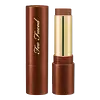What's inside
What's inside
 Key Ingredients
Key Ingredients

 Benefits
Benefits

 Concerns
Concerns

 Ingredients Side-by-side
Ingredients Side-by-side

Water
Skin ConditioningC12-15 Alkyl Benzoate
AntimicrobialPhenyl Trimethicone
Skin ConditioningSynthetic Wax
AbrasiveMica
Cosmetic ColorantSilica
AbrasiveDimethicone
EmollientOctyldodecanol
EmollientHydrogenated Polyisobutene
EmollientSorbitan Olivate
EmulsifyingBoron Nitride
AbsorbentDipentaerythrityl Hexa C5-9 Acid Esters
Skin ConditioningDiisostearyl Malate
EmollientCaprylyl Glycol
EmollientMethicone
EmollientSqualane
EmollientTheobroma Cacao Fruit Powder
Skin ConditioningButylene Glycol
HumectantCitrus Aurantium Dulcis Fruit Extract
MaskingPropylene Carbonate
Solvent1,2-Hexanediol
Skin ConditioningPalmitic Acid
EmollientStearic Acid
CleansingOleic Acid
EmollientArachidic Acid
CleansingCetyl Alcohol
EmollientSodium Chloride
MaskingEthylene/Propylene Copolymer
AbrasiveTriethoxycaprylylsilane
Myristic Acid
CleansingDisteardimonium Hectorite
StabilisingParfum
MaskingLimonene
PerfumingBenzyl Benzoate
AntimicrobialTocopheryl Acetate
AntioxidantCI 77891
Cosmetic ColorantCI 77491
Cosmetic ColorantCI 77492
Cosmetic ColorantCI 77499
Cosmetic ColorantWater, C12-15 Alkyl Benzoate, Phenyl Trimethicone, Synthetic Wax, Mica, Silica, Dimethicone, Octyldodecanol, Hydrogenated Polyisobutene, Sorbitan Olivate, Boron Nitride, Dipentaerythrityl Hexa C5-9 Acid Esters, Diisostearyl Malate, Caprylyl Glycol, Methicone, Squalane, Theobroma Cacao Fruit Powder, Butylene Glycol, Citrus Aurantium Dulcis Fruit Extract, Propylene Carbonate, 1,2-Hexanediol, Palmitic Acid, Stearic Acid, Oleic Acid, Arachidic Acid, Cetyl Alcohol, Sodium Chloride, Ethylene/Propylene Copolymer, Triethoxycaprylylsilane, Myristic Acid, Disteardimonium Hectorite, Parfum, Limonene, Benzyl Benzoate, Tocopheryl Acetate, CI 77891, CI 77491, CI 77492, CI 77499
Dicaprylyl Carbonate
EmollientEthylhexyl Palmitate
EmollientTitanium Dioxide
Cosmetic ColorantNeopentyl Glycol Diheptanoate
EmollientZinc Oxide
Cosmetic ColorantSynthetic Wax
AbrasiveSilica
AbrasiveHydrogenated Sunflower Seed Oil
Skin ConditioningGlyceryl Dibehenate
EmollientJojoba Esters
EmollientTribehenin
EmollientGlyceryl Behenate
EmollientSynthetic Fluorphlogopite
Lecithin
EmollientTocopherol
AntioxidantDisteardimonium Hectorite
StabilisingAscorbyl Palmitate
AntioxidantCitric Acid
BufferingCI 77492
Cosmetic ColorantCI 77891
Cosmetic ColorantCI 77491
Cosmetic ColorantCI 77499
Cosmetic ColorantDicaprylyl Carbonate, Ethylhexyl Palmitate, Titanium Dioxide, Neopentyl Glycol Diheptanoate, Zinc Oxide, Synthetic Wax, Silica, Hydrogenated Sunflower Seed Oil, Glyceryl Dibehenate, Jojoba Esters, Tribehenin, Glyceryl Behenate, Synthetic Fluorphlogopite, Lecithin, Tocopherol, Disteardimonium Hectorite, Ascorbyl Palmitate, Citric Acid, CI 77492, CI 77891, CI 77491, CI 77499
Ingredients Explained
These ingredients are found in both products.
Ingredients higher up in an ingredient list are typically present in a larger amount.
Ci 77491 is also hydrated iron III oxide. It's sole purpose is to give a red/pink hue to products.
Iron III oxides are classified as inorganic chemicals for coloring.
Synthetically created Ci 77491 is considered safer than those naturally found. This is because the synthetically created version may contain less impurities. Iron oxides are generally non-toxic and non-allergenic.
Learn more about CI 77491Ci 77492 is also hydrated iron III oxide. It's sole purpose is to give a yellow hue to products.
Iron III oxides are classified as inorganic chemicals for coloring.
Synthetically created Ci 77492 is considered safer than those naturally found. This is because the synthetically created version may contain less impurities. Iron oxides are generally non-toxic and non-allergenic.
Learn more about CI 77492Ci 77499 is also hydrated iron III oxide. It is created from mixing red and black iron oxides. This helps give shades of darkness to a product.
Iron III oxides are classified as inorganic chemicals for coloring.
Ci 77891 is a white pigment from Titanium dioxide. It is naturally found in minerals such as rutile and ilmenite.
It's main function is to add a white color to cosmetics. It can also be mixed with other colors to create different shades.
Ci 77891 is commonly found in sunscreens due to its ability to block UV rays.
Learn more about CI 77891Disteardimonium Hectorite comes from the clay mineral named hectorite. It is used to add thickness to a product.
It can also help stabilize a product by helping to disperse other ingredients.
Hectorite is a rare, white clay mineral.
Learn more about Disteardimonium HectoriteSilica, also known as silicon dioxide, is a naturally occurring mineral. It is used as a fine, spherical, and porous powder in cosmetics.
Though it has exfoliant properties, the function of silica varies depending on the product.
The unique structure of silica enhances the spreadability and adds smoothness, making it a great texture enhancer.
It is also used as an active carrier, emulsifier, and mattifier due to its ability to absorb excess oil.
In some products, tiny microneedles called spicules are made from silica or hydrolyzed sponge. When you rub them in, they lightly polish away dead skin layers and enhance the penetration of active ingredients.
Learn more about SilicaSynthetic Wax is created from fossil fuels such as natural gas. It is used to enhance texture, adjust pH, and as an occlusive.
It may also be used as an abrasive ingredient to exfoliate the skin.
Synthetic Wax may not be fungal acne safe.
Learn more about Synthetic Wax